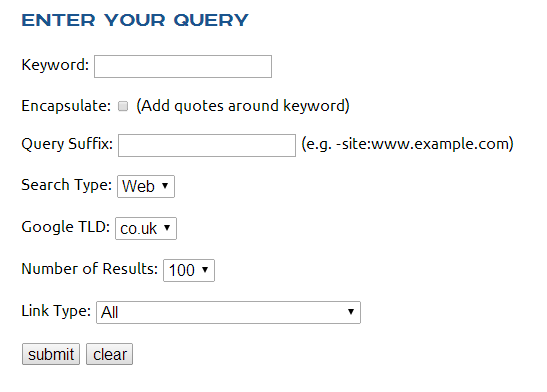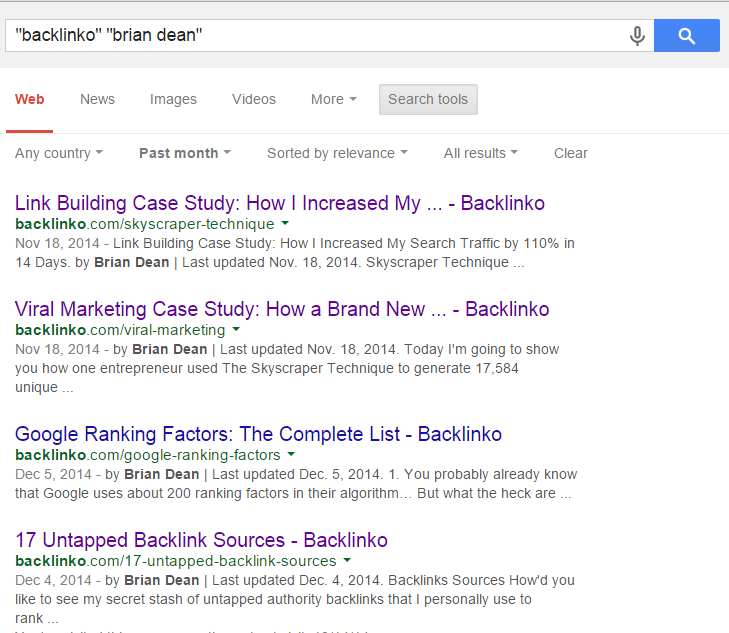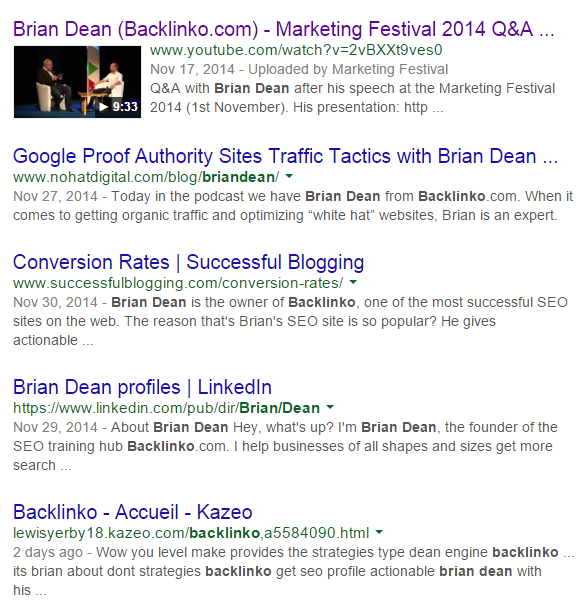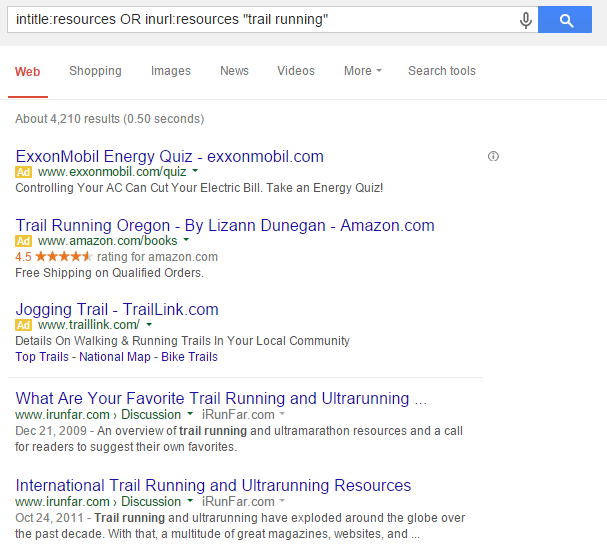by Venchito Tampon Jr | Last Updated on February 8, 2021
Link search is a phase in a brand’s link building campaign wherein most of the building efforts will highly depend on. This is where the success factors of link acquisition are noted, including:
- Obtainability of links, considering the types of links being built (contextual/site-wide, local/international, homepage/deep link, etc..)
- Standard or quality of content existed in various blogs/sites
When done right, link search will provide you thousands of link opportunities that your competitors may haven’t search for.
Below is a list of 12 link search tactics that you can use to create a giant spreadsheet of link prospects that you can later on reach out for link acquisition.
1. Advanced search query
There are many advanced search queries that you can use to prospect link opportunities based on the link building model you’re working on, but there’s only a handful of them that can help you find high quality link targets.
Thanks to Garett Brown that he took time to create this link search query builder. It is a very useful tool to semi-automate link prospecting targeting very niche-specific pages/sites, which are yielded from the keywords, search type, TLD and link type used in searching.
This is the most basic link search tactic that every new link builders must know. If you’re going advance, then you can read the following resources for more knowledge about link prospecting.
Useful Resources:
- Advanced Search Operators Guide: Tips for Searching the Web from SEO Experts
- 21 Link Builders Share Advanced Link Building Queries
2. Topical blogs
If most of your efforts revolve around building relationships with bloggers, then finding topical blogs is the best link search method for you.
Simply do a Google search (“industry” blog) for niches that are not directly connected to your brand but have a community of bloggers who might be interested to link to your page(s).
For instance, this link building blog is focused more on content marketing and link building topics than other internet marketing themes. But even though, I got high quality links from related sub-niches such as CRO, blogging, web design, affiliate marketing and student blogs.
If I would want to expand my link territory, then I can use the following search terms when prospecting for link opportunities, knowing that other niches might find my posts useful for them and probably link to my blog from their own content:
- “CRO” OR “conversion rate optimization” intitle:blog
- “Web design” intitle:blog OR “blog”
- “affiliate marketing” intitle:blog OR “blog”
In this link search method, you have to find the relevancy point between these niches and your brand, i.e. when you do outreach, you must be confident that they’re going to respond to your pitch because they are interested to what you offer.
3. List of lists
List posts are everywhere. And creating a list of these lists will give you hundreds of blogs that you can take advantage of for link building.
Searching for these list posts is easy. You can use the following search queries:
- Top 10 “industry”
- Top 50 “industry”
- Best of “industry”
- Ultimate list “industry”
If there are no list posts in your industry, then create one for your blog. You will have both a list of blogs/bloggers (that are potential linkers) and an added-value content that you can use for your pitch (telling bloggers that they’re one of your followers, as such, you included them in your latest content).
4. Brand partners
Putting brand partners in a list of link targets, for some marketers, would only be applicable for big companies who already had an opportunity to engage with other local and niche brands in the past. Since they had a database of existing partners, there’s a high chance to involve them into the company’s link development campaign.
However, for small to medium sized enterprises, there are still partners that they might consider for link acquisition such as the following groups of people:
- Suppliers / manufacturers who are connected to the brand.
- Local non-profit organizations where the brand had engaged in the past (i.e. sponsorships).
- Local educational institutions with specific courses directly aligned to the company.
- PR companies or news reporters who had just covered the brand for some good stories.
These groups of people can become your list of brand partners, wherein you can easily earn their trusts because of pre-existing relationships with these institutions.
For an ecommerce client, you won’t go anywhere else finding those brand partners. Just look at their website, find a page that says, “List of suppliers/manufacturers”. Start prospecting from there and add all potential link targets to your spreadsheet. However, if there are no existing pages like the example earlier, then simply do a Google search to find you brand partners.
5. Market-centered keywords
One of the key ways to collect profitable link prospects in your database is to understand your market and what your target audience is really looking for online.
For instance, if you’re working for a travel agency, you might consider industry phrases that’ll identify your market needs, such as:
- Travel list
- Travel guide in 2015
- Travel guide in [city/location]
- Best places to see in [location]
- Travel blog with pictures
As you can see, these are the exact phrases people are searching for online to find relevant resources or content about travel, “why” and “what” type of search terms (what is travel) is insignificant to the market needs since people are more likely interested with how’s (map of going to specific location) and when’s (dates/times of best attraction in the city).
6. Search dependent on content contributors
Showcasing your brand’s expertise through blogging (i.e. regular contribution on other related blogs) can drive traffic and referral visitors to your website. When using this approach, the common way to find prospects for guest blogs is adding the terms (“write for us” or “guest post”) to search query, “industry”.
Though you can already find a handful of blogs using that link search method, it won’t guarantee that those blogs are high quality and could provide value to your site (referral visitors and potential conversions).
One profitable approach to prospect for content contribution blogs is finding the best author/blogger in the industry or determining the most active content manager/marketer of your competitor.
Adding the name to the following search queries will end up having a bunch of blogs where the author had contributed his content to:
- “[Name] is a content contributor for [Competitor Domain].com”
- “[Name] is the author of”
- “[Name] is the blogger at”
- “[Name] is the owner of”
- [Name] “author” OR “blogger” OR “marketer”
So if you’re targeting 50 high quality niche-specific blogs, then using that link search approach above could easily help you achieve your goal.
7. Footprint prospecting
Finding footprints of your competitors can quickly help you search for low hanging fruits in link building. However, to some extent, if it is done in a regular basis and this is the only approach you’re executing, then you shouldn’t expect a higher competitive advantage over your competitors (since obviously, you’re just following what others had been doing in the past).
If you’re still building your brand from scratch, you can use footprint prospecting to find bloggers that you can connect with through blog commenting. This traditional link building technique still works when used as a pre-engagement activity before actually pitching bloggers for link requests or other content-led outreach methods.
A quick search query ([keyword] “leave a*” “comment”) could yield a good list of blogs where you can regularly check new posts and add useful and relevant insights in the comment section (to get into the radars of your target influencers).
You may also want to seek footprints of your competitors to find new link opportunities for your brand. Do Google searches for the following search strings:
- [competitor] “interview”
- [competitor] “news”
- [competitor] “press”
- [competitor] “author”
Then click “Search Tools” – Anytime – Past Month.
Here are a few things you can see in the search results:
- Author updates in the blog posts (i.e. editing texts and/or adding internal or external links to improve the page’s ranking potential).
- Text-based and video interviews.
- Webinars, podcasts and press releases of the brand associated by the author/owner.
- Social profiles of the author or the company.
Don’t just follow the brand and its existing authors/owners. You may also want to track the following brand elements and eventually track their future mentions in other blogs/sites.
- Future staff members
- Brand partnerships with relevant brands (supplier to manufacturer relationship)
- Books names or other content assets published by the brand (i.e. whitepaper “author” OR “whitepaper” author).
- Prominent interviewer always pop up in the search results when the search string (“competitor” OR “author” is used).
This link search method requires constant changes in search strings as it would need to adapt to updates happening in competitors’ brands and its industry.
8. Customer Defining Keywords
Customers when finding products or services in search are commonly using terms/phrases that define a target audience or their colleagues (fellow members) in the industry.
So gearing your link search towards what customers are defining their group members will help you discover highly qualified prospects instantly.
For example, if you own a running blog, you can use audience terms like:
- Runner
- Marathoner
- Sprinter
- Jogger
- Trackman
You can add more customer-defined keywords to your list by going to Thesaurus and searching for available synonyms.
You can also try visiting glossary pages in your niche and looking for specific terms that define groups of audience.
Instead of using the head industry keyword to prospect for link opportunities, you can use those customer-defining keywords to build a large database of link targets. In our given example, you can have the following search strings:
- Marathoner “blog”
- Marathoner “resources”
- Marathoner “guide”
- Marathoner “links”
Changing the given customer-defined keyword to other industry audience groups (sprinter, trackman, jogger, etc..) will give you another hundreds of opportunities that you can’t find by simply using the head term (running) in link prospecting.
9. Industry Thought Leaders
This is pretty much the same with footprint prospecting wherein you use names of authors from your competitors’ brands and add them to your advanced search operators to prospect for pages/sites where those authors had been mentioned.
Industry thought leaders do not only represent companies they’re working for but media outlets, content sites, branded pages and communities where thought leaders participated and are credited for their works (by linking to their brands using names as anchor texts).
Take note of brands with attached multiple authors and personalities since partnering with them can help amplify your content assets to a larger audience list (considering the number of followers each of the author has).
Consider Moz for example. The brand doesn’t just have one thought leader (Rand Fishkin) but three or more authors that are active in the community but represents one same company (Cyrus Shepard, Dr. Pete, Jen Lopez, etc..).
In this case, learning from what the thought leaders are working to build their own personal brands will best help your campaign to identify opportunities that will give good impressions for your company as well.
You may also try to determine what topics each industry leader is focusing on. Then try to invest in certain themes (one content theme at a time), then reach out to certain thought leaders who might be interested to consume and share your content.
With Moz, authors have their own themes when creating content:
- Rand Fishkin – videos, webinars and podcasts on advanced SEO and marketing topics (e.g. Whiteboard Friday).
- Pete – data-based content with graphs/illustrations (e.g. Google Answer Boxes)
- Cyrus Shepard – ultimate guides and curated content on advanced SEO topics (e.g. Advanced SEO Concepts)
Pro tip: Adding expertise phrases of authors to search strings (e.g. “guide” “Cyrus Shepard”) would give you pages/sites where content assets of authors had been mentioned.
10. Product/Category Keywords
One of the under-utilized approaches in searching for link targets is adding brand’s categories to search strings. This method will uncover hundreds of opportunities target each and every type of product your brand is able to sell.
Start by talking to your client on what types of products they are selling or simply go their website and look for brand categories.
In our earlier example, you can have these types of products:
- Flat feet running shoes
- High-arched feet running shoes
- Neutral running shoes
- Normal running shoes
Add your favorite keywords (reviews, forum, blogs) to categories (example above) to find loads of pages/websites that can potentially link to your content.
11. Local-specific Keywords
Making your search strings tailored to a local audience helps you discover and participate with local press outlets that have high chances of driving local traffic, resulting in an increase in sales.
Combine your favorite keywords (reviews, resources, blogs) and local areas (e.g. Brisbane) to find local pages or sites. You can also be specific with cities by adding region or state, as well as Zip Codes to prospect for easy link opportunities.
12. Resource Page Terms
Seeking for link opportunities especially resources/links pages requires creativity in brainstorming for new search strings. This is true for industries that don’t have many pages for resources.
In this case, you need to understand what industry terms webmasters are using or targeting in their existing links/resource pages.
In running niche, you can be as specific as possible when doing link search (to find resource pages).
Here is an example of using very specific search terms for resource pages:
- intitle:resources OR inurl:resources “trail running”
- intitle:resources OR inurl:resources “kids running”
- intitle:resources OR inurl:resources “mountain running”
The more specific your search is, the easier for you to filter out irrelevant pages in search results and only qualify those sites that are high quality.
Pro tip: Always check out related verticals as you go looking for link prospects. This might uncover opportunities that could otherwise be undiscovered. In our example, adding these keywords “fitness resources” or “personal training” resources will help you build a large database of link targets.
Other Useful Resources:
If you’re looking for a high quality link building service, then you can contact our team to help you create a link strategy that fits your brand and industry.
The Author
Venchito Tampon Jr
Venchito Tampon is a Filipino Motivational Speaker, Corporate Trainer, and a Leadership Speaker in the Philippines. He is the CEO and Co-Founder of SharpRocket, a link building agency. With a decade of experience, Venchito has a proven track record of leading hundreds of successful SEO (link builidng) campaigns across competitive industries like finance, B2B, legal, and SaaS. His expert advice as a link building expert has been featured in renowned publications such as Semrush, Ahrefs, Huffington Post and Forbes. He is also an international SEO spoken and has delivered talks in SEO Zraz, Asia Pacific Affiliate Summit in Singapore, and Search Marketing Summit in Sydney, Australia. Check out his other businesses, Hills & Valleys Cafe, Blend N Sips and Saas Pursuit.
How our LINK BUILDING AGENCY builds 250 links/mo consistently using Predictable Link Building Methodology™…
- Using a SIMPLE and PROVEN system
- Using a SCALABLE strategy
- No private blog networks
- No creepy outreach emails








